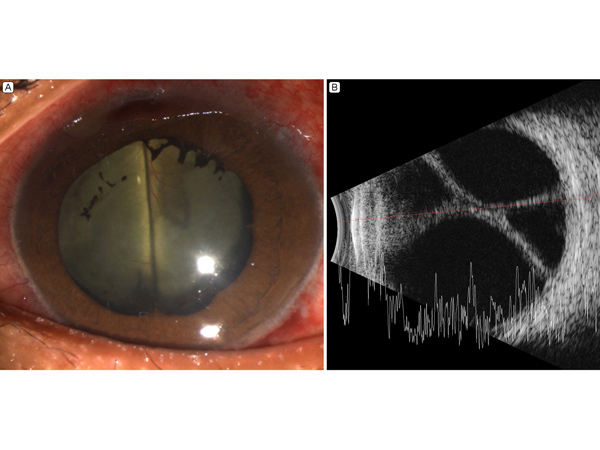Kissing choroidal detachment
Aug 6, 2021
Volume 27, Number 3
Subodh Lakra, MBBS, MS | Glaucoma Research Facility and Clinical Services, Dr Rajendra Prasad Center for Ophthalmic Sciences, All India Institute of Medical Sciences, New Delhi
Gazella Bruce Warjri, MS | Glaucoma Research Facility and Clinical Services, Dr Rajendra Prasad Center for Ophthalmic Sciences, All India Institute of Medical Sciences, New Delhi
Ramanjit Sihota, MD, FRCS | Glaucoma Research Facility and Clinical Services, Dr Rajendra Prasad Center for Ophthalmic Sciences, All India Institute of Medical Sciences, New Delhi

A 19-year-old man presented for routine follow-up at the Glaucoma Clinic of All India Institute of Medical Sciences, New Delhi, 1 week after undergoing trabeculectomy in both eyes for juvenile open-angle glaucoma. On examination, visual acuity was 4/60 in left eye, with intraocular pressure of 2 mm Hg. Slit-lamp examination showed a superior nasal bleb, shallow anterior chamber, and kissing choroidal detachments behind the clear lens (A). A Seidel test was negative. B-scan ultrasound confirmed choroidal detachment in the left eye (B). Initially, conservative management was planned, with topical difluprednate (0.05%) every 2 hours, oral prednisolone (1 mg/kg bodyweight), and atropine ointment 1% before surgical intervention. Within 2 weeks, however, the mounds had disappeared on slit-lamp examination; by 6 weeks visual acuity had improved to 6/9, and the choroidal detachment resolved completely.
 Welcome, please sign in
Welcome, please sign in  Welcome, please sign in
Welcome, please sign in